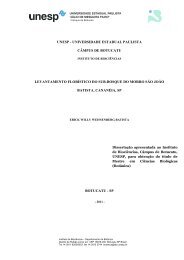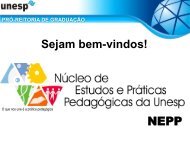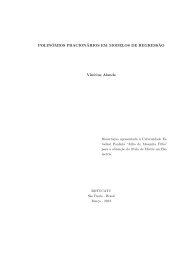Impactos de pisciculturas em tanques-rede sobre a ictiofauna da ...
Impactos de pisciculturas em tanques-rede sobre a ictiofauna da ...
Impactos de pisciculturas em tanques-rede sobre a ictiofauna da ...
You also want an ePaper? Increase the reach of your titles
YUMPU automatically turns print PDFs into web optimized ePapers that Google loves.
Abstract<br />
Sist<strong>em</strong>as <strong>de</strong> <strong>pisciculturas</strong> <strong>em</strong> <strong>tanques</strong>-re<strong>de</strong> modificando a alimentação <strong>de</strong> peixes nativos<br />
Autor: Igor Paiva Ramos<br />
Historically, Brazilian ichthyofauna of large rivers has been subjected to anthropogenic<br />
interference, such as impoundments. Consequently, fish farming syst<strong>em</strong>s in cages are a<br />
currently new source of impact upon aquatic ecosyst<strong>em</strong>. Characterizing the impacts of<br />
freshwater fish farms on the feeding of five species of Neotropical freshwater fish, associated<br />
with these activities, was the objective of this study. Specimens of Astyanax altiparanae,<br />
Galeocharax knerii, Iheringicthys labrosus, Pimelodus maculatus and Plagioscion<br />
squamosissimus were sampled in areas around the two syst<strong>em</strong>s of fish farming in cages (CF),<br />
and two control areas (CT) without the influence of this activity. The results show that there<br />
were significant changes in the diet of trophic generalist species (A. altiparanae, P. maculatus<br />
and I. labrosus) with consequent increase in condition factor values of such species in tank<br />
areas. Trophic specialist species, such as the carnivorous fish species G. knerii and P.<br />
squamosissimus, showed small differences between CF and CT areas regarding the diet, and<br />
showed no differences in other analyses performed. It is conclu<strong>de</strong>d that fish farms in cages<br />
affect the natural diet of trophic generalists fish species, with a direct effect on nutritional<br />
status (condition factor), and food wastes is one of the main it<strong>em</strong>s consumed by this trophic<br />
guild. The results indicate that these species are responsible for recycling a great portion of<br />
organic matter transferred by this type of activity, which along with local fisheries activities<br />
contribute to mitigate associated processes of eutrophication.<br />
Key words: diet, condition factor, niche breadth, aggregate ichthyofauna, native fish<br />
20
















